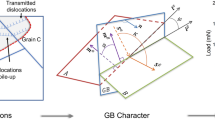Abstract
A study is made of the formation of dislocations in silicon with local damage to the surface at room temperature and subsequent annealing within the range 1073–1473 K. The damages to the surface are modeled with the use of micro-hardness indentations. Measurements of mean linear dislocation density in a ray of the indentation rosette show that the number of dislocations in the rosette is independent of both the temperature and duration of isothermal annealing. It was found that annealing at 573–773 K leads to partial relaxation of elastic stresses from the indentation due to the formation of sections of silicon with a hexagonal structure near the indentation. Further annealing at high temperatures leads to the disappearance of these sections and the formation of a normal dislocation rosette, with the number of dislocations in the rays corresponding to the case of one-stage annealing. The results are empirical confirmation of the hypothesis of “incomplete shear.” In accordance with the latter, dislocations are formed during deformation at room temperature, not during subsequent annealing.
Similar content being viewed by others
Literature cited
H. Grinauer, Semicond. Silicon, Princeton Univ. Press, NJ (1973), pp. 468–495.
M. I. Hill and D. J. Rowcliff, J. Mat. Sci.,9, No. 10, 1569–1576 (1974).
Yu. A. Kontsevoi, Yu. M. Litvinov, and É. A. Fattakhov, Plasticity and Strength of Semiconducting Materials and Structures [in Russian], Radio i Svyaz', Moscow (1982).
V. I. Trefilov and Yu. V. Mil'man, Dokl. Akad. Nauk SSSR,153, No. 4, 824–827 (1963).
J. Hirth and J. Lothe, Theory of Dislocations, McGraw-Hill, New York (1967).
M. G. Mil'vidskii, V. B. Osvenskii, B. A. Sakharov, and S. S. Shifrin, Dokl. Akad. Nauk SSSR,207, No. 5, 1109–1111 (1972).
S. M. Hu, Appl. Phys. Lett.,31, No. 3, 139–141 (1977).
Pa Tu and He Yizhen, Phys. Status Solidi,A59, No. 1, 195–200 (1980).
S. I. Kusakin, Yu. M. Litvinov, and A. V. Prikhod'ko, Fiz. Khim. Obrab. Mater., No. 3, 105–111 (1981).
S. S. Gorelik, Yu. M. Litvinov, and A. V. Prikhod'ko, Poverkhnost'. Fizika, Khimiya, Mekhanika, No. 5, 80–83 (1985).
J. Eshelby, Continuum Theory of Dislocations [Russian translation], IL, Moscow (1963).
S. S. Gorelik, Yu. M. Litvinov, S. P. Pavlo, and A. V. Prikhod'ko, Izv. Vyssh. Uchebn. Zaved., Fiz., No. 7, 26–30 (1983).
V. G. Eremenko and V. I. Nikitenko, Phys. Status Solidi,A14, No. 1, 317–340 (1972).
N. L. Aptekar' and E. Yu. Tonkov, Fiz. Tverd. Tela,17, No. 5, 1488–1490 (1975).
P. Pirouz, R. Cheim, and J. Samuels, Izv. Akad. Nauk SSSR, Ser. Fiz.,51, No. 4, 753–762 (1987).
Additional information
Zaporozh'e University. Translated from Izvestiya Vysshikh Uchebnykh Zavedenii, Fizika, No. 5, pp. 78–82, May, 1992.
Rights and permissions
About this article
Cite this article
Levitan, S.F., Litvinov, Y.M. & Prikhod'ko, A.V. Formation of dislocations with local mechanical damage to a silicon surface at room temperature. Russ Phys J 35, 461–464 (1992). https://doi.org/10.1007/BF00558859
Received:
Revised:
Issue Date:
DOI: https://doi.org/10.1007/BF00558859




